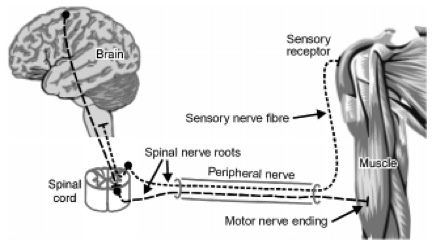Muscle Power and Muscle Contraction

What is Power?
You may remember it from your old high school physics class, or from your terribly boring Gen-ed requirement course in College as P = F · v. or force times velocity is power. This equation maybe be beneficial to a physicist or physiological researcher, but for the average person, to know this is to know nothing. We know power differently, and see it in action all the time. Whether we are watching a cheeta slam a gazelle into the ground at 65 mph on animal planet, or when we see Ray Lewis knocking the lights out of crossing reciever on ESPN. It's dynamic. It's fast. It's certainly scary, but no less awe-inspiring. Ultimately, It's a blast of energy; and then it's over. That's power.

Where Does 'Human Power' Come From?
Our power is ultimately a product of our muscular contractions. Those are when muscle fibers generate tension during the action of actin and myosin cross-bridge cycling; there are three types: Concentric (which results in the shortening of the muscle belly), Eccentric (which results in the lengthing of the muscle belly), and Isometric (which is static; neither lengthens or shortens the muscle belly). For the average Joe, concentric is lifting resistance, eccentric is lowering resistance, and isometric is holding resistance in place. When we lift weights, do pilates, walk around Walmart, write an article on Hubpages, we move by the means of these muscular contractions. We contract our muscles through the neuromuscular messages sent throughout our intricit nervous system, and all these movements are supported by our strong skeletal system. This connection between our muscles, nerves, and bones is known as the kinetic chain. These are the bodily systems that enable us to move. Through optimal training (proper stress, proper rest), we can improve the mechanical efficency and the biological efficency of our kinetic chain, and thus increasing our strength, muscle size, speed, endurance, sport-specific skills, and flexibility.
Let Us Apply This Scientific Jargon
In a study called The Effect of Loss of Visual Input on Muscle Power in Resistance Trained and Untrained Young Men and Women from The Journal of Strength and Conditioning Research, Killebrew et al tested the concentric power output of 27 college-aged students (19-23 years old) during a seated bilateral leg press for two trials; one were participants were blindfolded and one that performed normally. Killebrew found that both trained and untrained men and women lost power output when blindfolded during exercise. Untrained participants were particularly weaker with no visual input. Most likely as a result of underdeveloped biomechanical pathways, or in other words, a weaker mind-to-muscle connection. Is seems obvious then, that there is something special about visualization that increases our power output.
Visualization is Key

If you have ever opened any Muscle & Fitness magazine, Men's Health, Woman's Health, Oxygen, chances are you have come across an article mentioning the benefits of visualizing an exercise or movement through several reps before you attempt a set with weights. But when you hop on the bench and get ready to lift, what should we be thinking then? I believe this is entirely dependent on your goals. Do you want Herculean strength? Do you wish to sculpt your quads like the Gods? Do you want to run from Marathon to Athens, and not fall dead like Pheidippides? Just as the foundation of training sets, reps, rest intervals, and intensities vary from bodybuilding, powerlifting, crossfit, and sports, our visualization and execution of every rep must also be specific to our goals.

How Should We Concentrate Our Efforts?
Depsite the decrease in power output when our focus is exclusively internal, or only relying on our biomechanical pathways to guide us through exercise (Such as closing our eyes or being blindfolded during exercise), this is the best way to make them more efficent and thus generating strong contractions and greater mind-to-muscle connections. This is particularly useful for someone who is interested in hyperthrophy; whether you want to add a few inches to your arms, or sculpt an impeccible pair of glutes, internal focusing on the contraction of your muscle will result in greater tension, bigger vascular pumps, and an increased bodily awareness. This method of visualization during exercise works well with pilates and yoga, as well as an athlete that wishes to improve their sense of balence and bodily awareness.
Someone who is interested in increasing their 1-Rep Max, however, will benefit very little from the above technique. When training for strength, there is only one goal, move as much weight as possible from point A to point B. In this instance, you want to recruit as many muscle fibers as possible to aid in lifting the weight. Certainly, you must contract our whole body in order to stabilize the weight. This by itself takes a temendous effort and needs practice. But the last thing you need to do when you are this tense is to close your eyes and make the exercise more challenging. Since you are more interested in your performance, rather than appearance, you would simply focus your energies on moving the weight at all costs. This method of visualization during exercise works well with balistic exercises, plyometrics, and olympic lifts.
The ultimate concensus; feel your muscles to grow your muscles, or, focus on the weights to move more weights.








